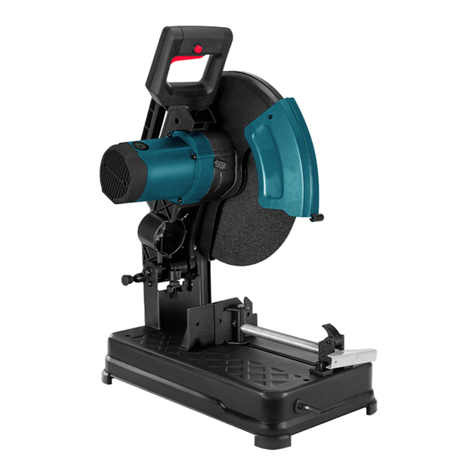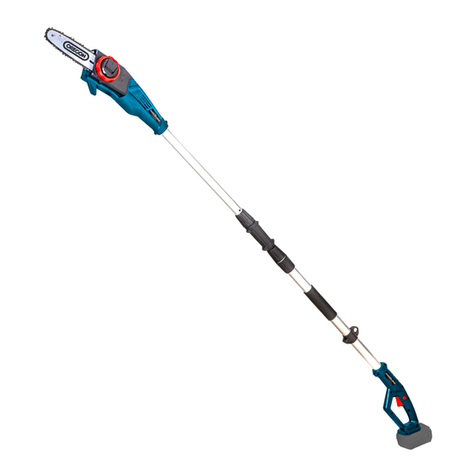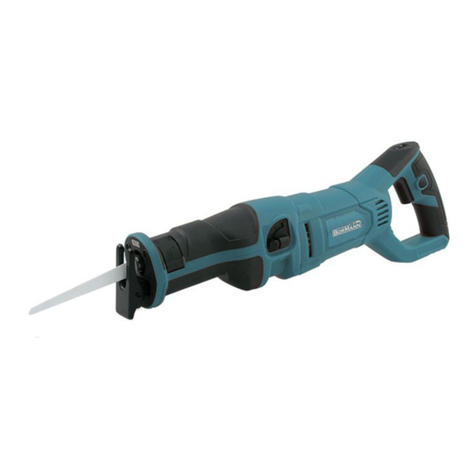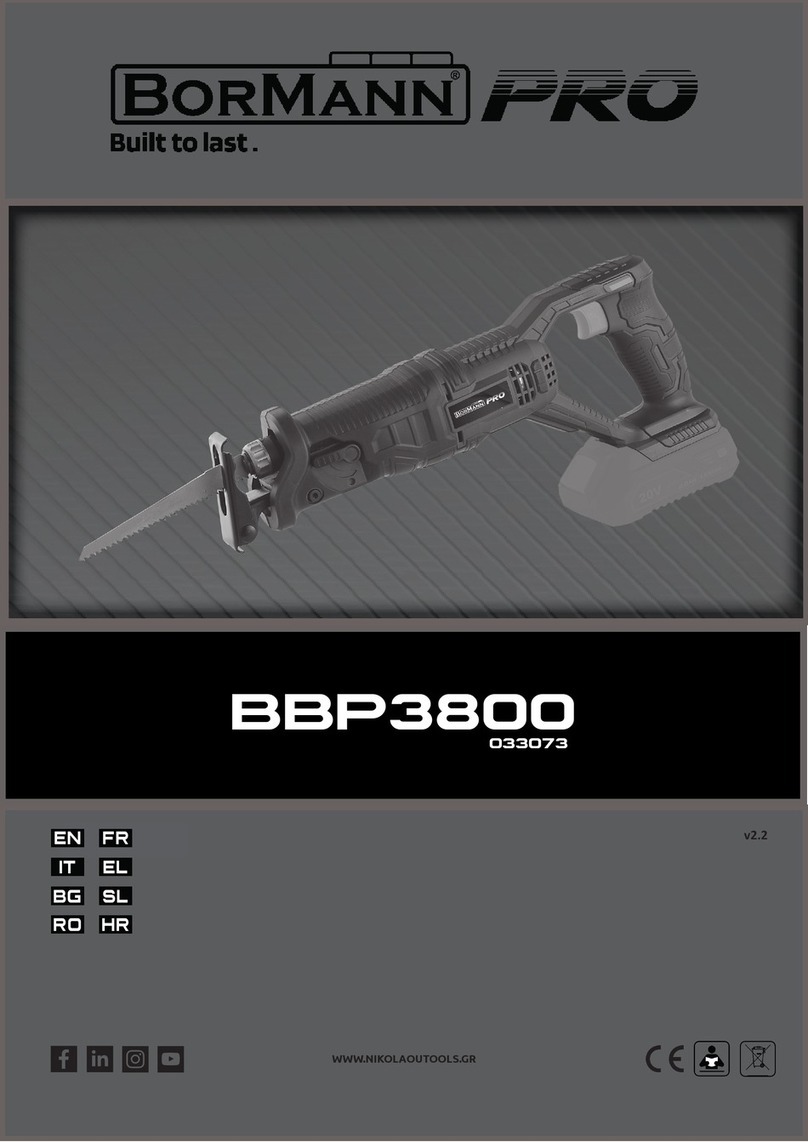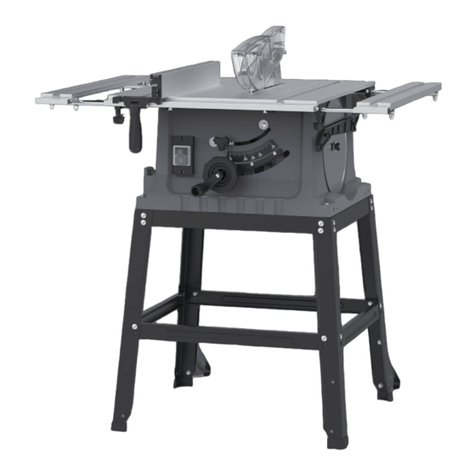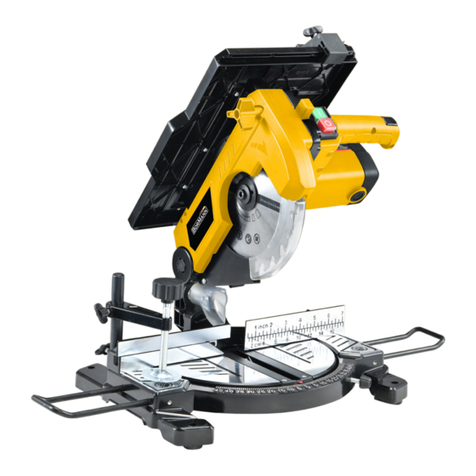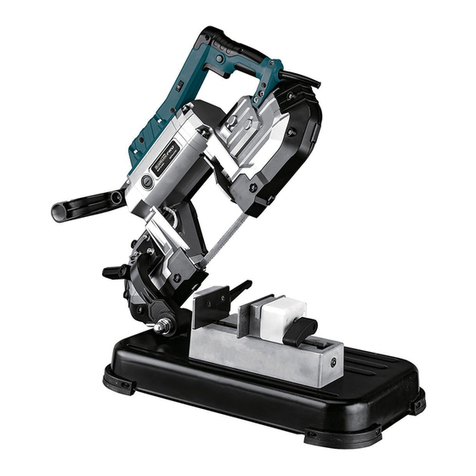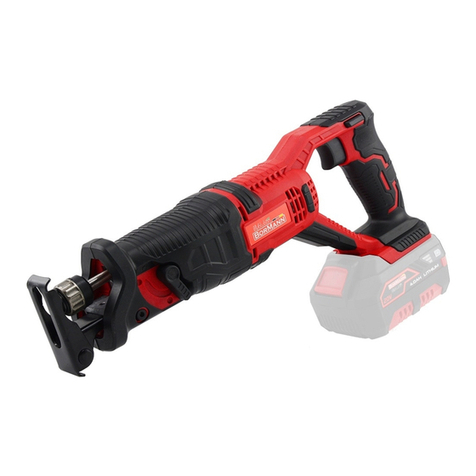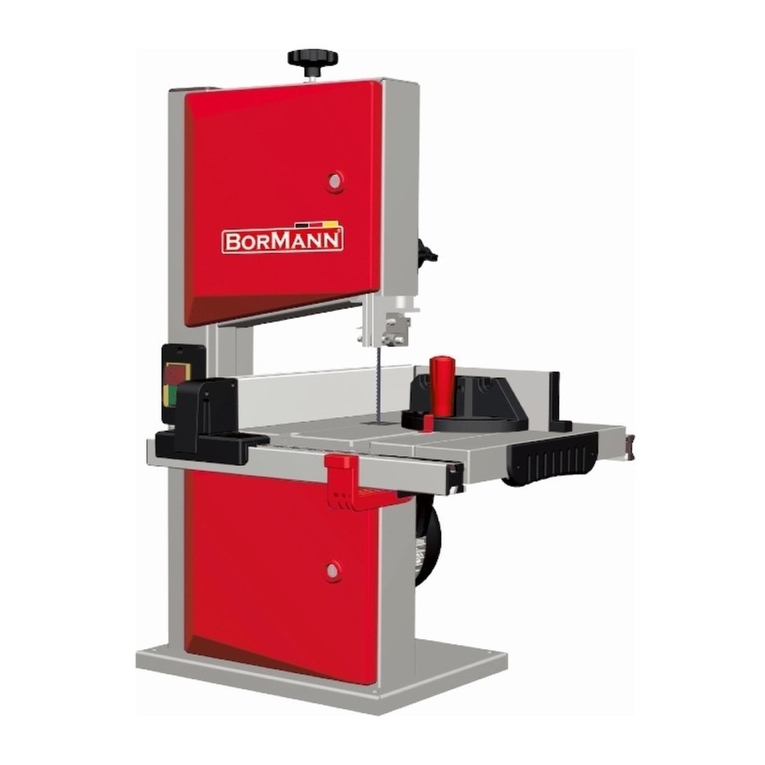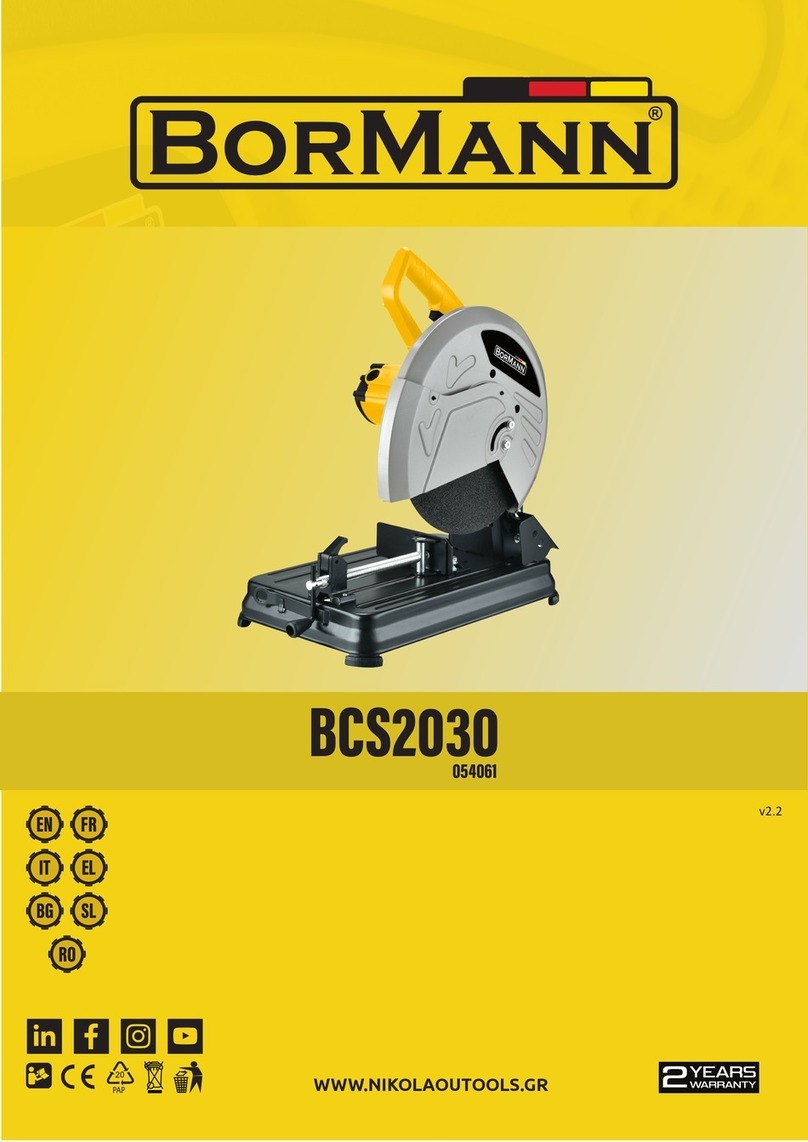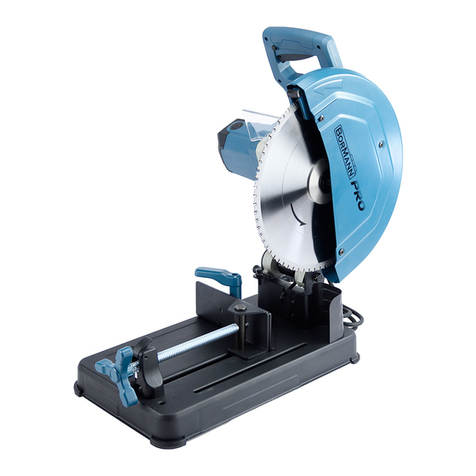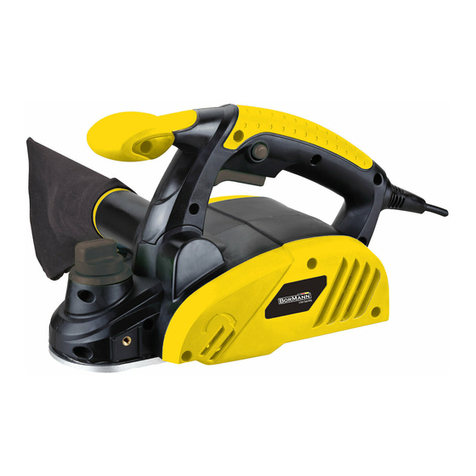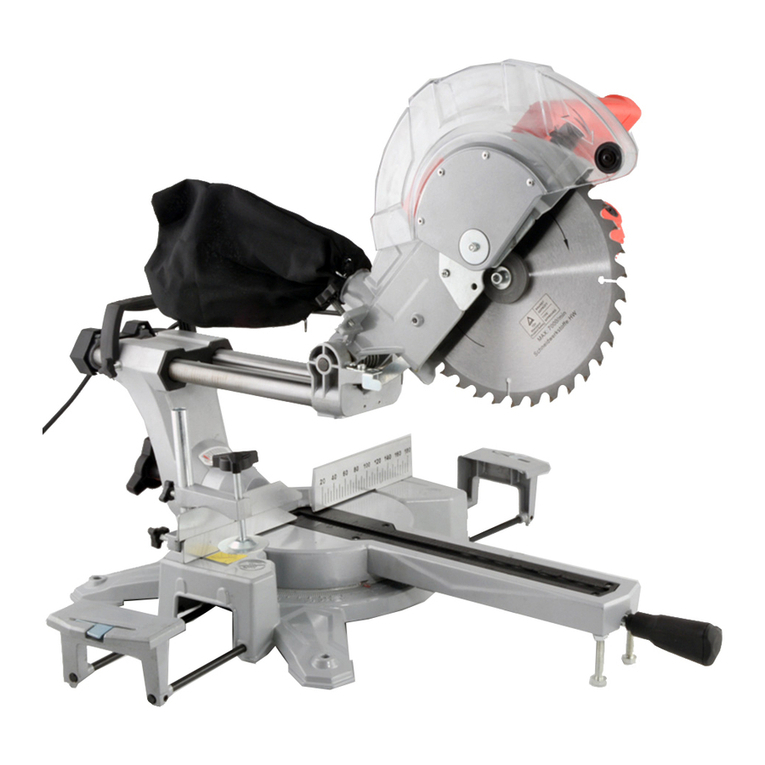
5
EN EN
II. Safety instrucons for mitre saws
III. Extra instructions for this mitre saw
a) Mitre saws are intended to cut wood or wood-like products, they cannot be used with abrasive cut-o wheels for cung ferrous material such as bars,
rods, studs, etc. Abrasive dust causes moving parts such as the lower guard to jam. Sparks from abrasive cung will burn the lower guard, the kerf insert and
other plasc parts.
b) Use clamps to support the workpiece whenever possible. If supporng the workpiece by hand, you must always keep your hand at least 100 mm from
either side of the saw blade.
Do not use this saw to cut pieces that are too small to be securely clamped or held by hand.
If your hand is placed too close to the saw blade, there is an increased risk of injury from blade contact.
c) The workpiece must be staonary and clamped or held against both the fence and the table. Do not feed the workpiece into the blade or cut “freehand” in
any way. Unrestrained or moving workpieces could be thrown at high speeds, causing injury.
d) Push the saw through the workpiece. Do not pull the saw through the workpiece. To make a cut, raise the saw head and pull it out over the workpiece
without cung, start the motor, press the saw head down and push the saw through the workpiece. Cung on the pull stroke is likely to cause the saw blade
to climb on top of the workpiece and violently throw the blade assembly towards the operator.
e) Never cross your hand over the intended line of cung either in front or behind the saw blade. Supporng the workpiece “cross handed” i.e. holding the
workpiece to the right of the saw blade with your le hand or vice versa is very dangerous.
f) Do not reach behind the fence with either hand closer than 100mmfromeither side of the saw blade, to remove wood scraps, or for any other reason while
the blade is spinning. The proximity of the spinning saw blade to your hand may not be obvious and you may be seriously injured.
g) Inspect your workpiece before cung. If the workpiece is bowed or warped, clamp it with the outside bowed face toward the fence. Always make certain
that there is no gap between the workpiece, fence and table along the line of the cut. Bent or warped workpieces can twist or shi and may cause binding on
the spinning saw blade while cung. There should be no nails or foreign objects in the workpiece.
h) Do not use the saw unl the table is clear of all tools, wood scraps, etc., except for the workpiece. Small debris or loose pieces of wood or other objects
that contact the revolving blade can be thrown with high speed.
i) Cut only one workpiece at a me. Stacked mulple workpieces cannot be adequately clamped or braced and may bind on the blade or shi during cung.
j) Ensure the mitre saw is mounted or placed on a level, rm work surface before use. A level and rm work surface reduces the risk of the mitre saw becom-
ing unstable.
k) Plan your work. Every me you change the bevel or mitre angle seng, make sure the adjustable fence is set correctly to support the workpiece and will
not interfere with the blade or the guarding system. Without turning the tool ²ON² and with no workpiece on the table, move the saw blade through a com-
plete simulated cut to assure there will be no interference or danger of cung the fence.
l) Provide adequate support such as table extensions, saw horses, etc. for a workpiece that is wider or longer than the table top. Workpieces longer or wider
than the mitre saw table can p if not securely supported. If the cut-o piece or workpiece ps, it can li the lower guard or be thrown by the spinning blade.
m) Do not use another person as a substute for a table extension or as addional support.
Unstable support for the workpiece can cause the blade to bind or the workpiece to shi during the cung operaon pulling you and the helper into the
spinning blade.
n) The cut-o piece must not be jammed or pressed by any means against the spinning saw blade. If conned, i.e. using length stops, the cut-o piece could
get wedged against the blade and thrown violently.
o) Always use a clamp or a xture designed to properly support round material such as rods or tubing. Rods have a tendency to roll while being cut, causing
the blade to ²bite² and pull the work with your hand into the blade.
p) Let the blade reach full speed before contacng the workpiece. This will reduce the risk of the workpiece being thrown.
q) If the workpiece or blade becomes jammed, turn the mitre saw o. Wait for all moving parts to stop and disconnect the plug from the power source and/
or remove the baery pack. Then work to free the jammed material. Connued sawing with a jammed workpiece could cause loss of control or damage to
the mitre saw.
r) Aer nishing the cut, release the switch, hold the saw head down and wait for the blade to stop before removing the cut-o piece. Reaching with your
hand near the coasng blade is dangerous.
s) Hold the handle rmly when making an incomplete cut or when releasing the switch before the saw head is completely in the down posion. The braking
acon of the saw may cause the saw head to be suddenly pulled downward, causing a risk of injury.
CAUTION! Use of controls or adjustments or performance of procedures other
than those specied herein may result in hazardous radiaon exposure.
WARNING! This product produces an electromagnec eld during operaon! This eld may under some circumstances interfere with acve or
passive medical implants! To reduce the risk of serious or fatal injury, we recommend persons with medical implants to consult their doctor and
the medical implant manufacturer before operang this product!
EMERGENCY
Familiarize yourself with the use of this product by means of this instrucon manual. Memorize the safety direcons and follow them to the leer. This
will help to prevent risks and hazards.
1. Always be alert when using this product, so that you can recognize and handle risks early. Fast intervenon can prevent serious injury and damage to
property.
2. Switch o and disconnect from the power supply if there is any malfuncon. Have the product checked by a qualied specialist and repaired, if necessary,
before you put it into operaon again.
RESIDUAL RISKS
Even if you use this electric power tool in accordance with instrucons, certain residual risks cannot be rules out. The following hazards may arise in con-
necon with the equipment’s construcon and layout:
1. Lung damage if no suitable protecve dust mask is used.
2. Damage to hearing if no suitable ear protecon is used.
3. Health damage caused by hand-arm vibraons if the equipment is used over a prolonged period or is not properly guided and maintained.
WWW.NIKOLAOUTOOLS.GR






